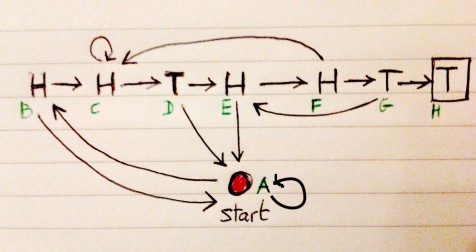
Start flipping a coin. How long should you wait (on average) before observing the pattern !? Easy you might say, that’s simply the hitting time of the state
starting from state
of the following Markov chain.

Indeed, one can solve this kind of problem using a first step analysis. In other words, if is the expected number of steps before reaching
starting from
,
is the expected number of steps before reaching
starting from
,
is the expected number of steps before reaching
starting from
, etc… one can readily see that
verify the system of equations
After a finite amount of time and coffee one then come up with the answer . That was a little bit tedious and I don’t really want to know how long one should wait on average before observing the sequence
.
It turns out that there is a very neat way to approach this kind of problems without solving any linear system. Apparently, this trick was discovered in the 80s by Shuo-Yen Robert Li. As often in probability, this boils down to introducing a clever martingale. Suppose that one wants to know how long it takes on average before observing the magic coin pattern of length
with
for all
. To this end, one will introduce an army of gamblers, a casino, a game of chance and a martingale. The martingale
describes the amount of money earned by the casino. At each round (starting at round
) the casino tosses a coin and the gamblers can make bets. If a gambler starts betting just before round
, he wins if the coin shows
. If he decides to bet again at round
, he wins if the coin shows
, etc… Suppose that there are infinitely many gamblers
and that gambler
starts betting just before round
. The game is fair in the sense that if a gambler bets an amount
, with probability
he gets
and with probability
he losses his bet. One supposes that gambler
starts betting
dollar just before round
and keeps reinvesting his total capital until he either losses everything (total loss equals
dollar) or observes the magic coin pattern
(total earning equals
). Indeed, the amount of money earned by the casino is a martingale and
. For example,
if the first gambler
loses his bet and
if the wins. Consider the time
when the magic coin pattern first appears. This is a stopping time and the optional stopping theorem for martingales shows that
. Indeed, one can also compute this quantity another way. By time
, all the losers have given
dollar to the casino. Also, if the gambler
is still in the game he has won a total amount
. in other words,
where if the gambler
is still in the game after the round
and
otherwise. The fundamental remark is that the quantity
is not random so that
. Indeed, right after round
one can know with certainty whether
is still in the game or not. Gambler
is in the game only if the
last letters of the magic word
are the same as the first
letters. For example, if the magic word is
then the gamblers who have seen the pattern
,
and
at time
are still in the game when the magic word first appear. In this case this shows that
.

For example, this immediately shows that we have to wait on average coin tosses before observing the pattern
.




